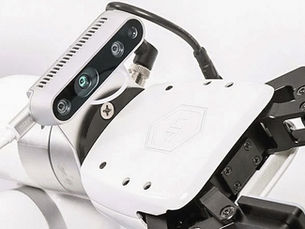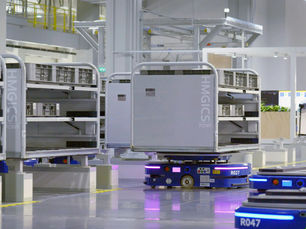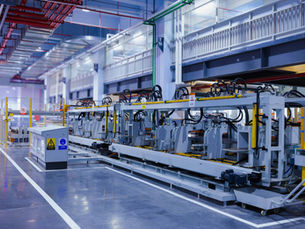top of page


Understanding Pick and Place Robot Costs: From DIY to Full Automation
In recent years, the integration of automation in manufacturing and logistics has gained immense momentum, with advanced pick-and-place systems significantly enhancing throughput and operational consistency. This trend is particularly noteworthy as supply chains continue to recover from recent disruptions and labor challenges persist, making 2025 a pivotal year for the proliferation of more accessible, cost-effective robotics solutions. For industry players, particularly thos
5 min read


How Machine Tending Automation Works — And the Philosophies That Drive It
Machine tending is the process of loading raw parts into a machine (like a CNC, injection molding press, or press brake), monitoring the cycle, and unloading the finished part. Traditionally, operators handled this task manually—placing material, pressing start, and removing the part when done.
3 min read


Material Handling Automation: What It Is, Why It Matters, and How It Works
The systems that move, store, and protect those materials are what we call material handling. When we add robotics, sensors, and smart software, we get material handling and automation, and that’s been changing the game.
2 min read


Case Packing Robots: Everything You Need to Know
If you’ve ever walked through a warehouse or production line, you’ve probably seen workers loading products into boxes by hand. It’s a repetitive, time-consuming job that’s also physically demanding. That’s where case packing robots come in.
3 min read


How Macrovey’s Mobile Warehouse System Exemplifies the Future of 3PL Automation
In the ever-evolving world of third-party logistics (3PL), the pressure is on: faster fulfillment, more SKU variety, less labor, and tighter margins. E-commerce has pushed expectations sky-high, and traditional warehouse operations are often ill-equipped to handle the complexity. That’s why the Mobile Warehouse System developed by Macrovey in collaboration with Blue Sky Robotics is a breakthrough worth examining. This project rethinks what automation looks like in 3PL environ
5 min read


Choosing the Right Warehouse Automation Solution for Your Business
Warehouse automation is not one-size-fits-all. This blog guides you through selecting the right automation strategy and tools—whether it’s AMRs, AS/RS, robotic picking, or conveyor systems. We’ll explain the decision points: facility size, order volume, staff readiness, and integration capabilities. The article also includes key metrics to measure post-deployment ROI and operational lift. Ideal for growing businesses ready to scale with technology that aligns with their needs
2 min read


What Is an AS/RS and Should Your Warehouse Have One?
What is an AS/RS? An Automated Storage and Retrieval System (ASRS) is a high-efficiency warehousing solution that helps companies store more, pick faster, and reduce labor needs. From shuttle systems to vertical lifts, learn how these tools are transforming warehouses into lean, automated powerhouses.
2 min read


How to Automate Warehousing Without Breaking Your Operations
Warehouse automation doesn’t have to be a disruptive, expensive transformation. With a smart plan and modular tools, you can automate high-impact processes, improve throughput, and reduce labor stress—all without shutting down your operation.
3 min read


Top Pick and Place Automation Tools in 2025
As warehouses race to improve efficiency, reduce labor dependency, and meet rising consumer expectations, pick-and-place automation has taken center stage.
4 min read


The Role of AS/RS in the Smart Warehouse Revolution
As global supply chains grow more complex and labor shortages continue to affect logistics operations, automated storage and retrieval systems (AS/RS) have become a cornerstone of the smart warehouse.
4 min read


Top 5 Industrial Automation Technologies Transforming Modern Warehouses
From small businesses to massive 3PL operations, industrial automation is no longer a futuristic option—it’s a competitive necessity. But what technologies are truly leading this transformation?
3 min read


Cobots in the Warehouse: Collaborative Robots Boosting Efficiency
Cobots, or collaborative robots, are transforming warehouse operations by working safely alongside humans to boost efficiency and safety. Unlike traditional warehouse robots, cobots handle repetitive tasks like picking, packing, and transport, allowing workers to focus on higher-value work. Ideal for flexible, scalable automation, cobots are a key part of the modern robotics warehouse, improving productivity while reducing injuries and operational costs.
4 min read


Are Robotics in Warehouse Automation Worth It for Small to Mid-Sized 3PLs?
Robotics warehouse automation refers to the use of intelligent systems, robotics, and autonomous machines to perform repetitive tasks in a warehouse—like picking, packing, transporting, and storing goods. These technologies aim to optimize operations by reducing human labor, increasing accuracy, and improving throughput.
4 min read


How Are Third-Party Logistics Providers Using Robotics to Stay Competitive?
With e-commerce accelerating and delivery expectations higher than ever, third-party logistics (3PL) providers face growing pressure to fulfill faster, safer, and at greater scale. To stay competitive in this high-demand landscape, many 3PLs are turning to robotics and warehouse automation—not just as upgrades, but as foundational tools for transforming how logistics is done.
5 min read


The Rise of the Cobot Welder: How Collaborative Robots Make Welding Easier for Fabricators
This article explains how cobot welders work and outlines their benefits in productivity, cost reduction, ease-of-use, weld quality, safety, and system selection. Transitioning from traditional welding to collaborative robotic welding is not only a technological upgrade but also a strategic move toward safer, more efficient, and scalable manufacturing.
6 min read


Affordable Robotic Arms: How Advanced Manufacturing and Streamlined Supply Chains Are Revolutionizing Robotics
In recent years, the robotics industry has undergone a remarkable transformation, making robotic arms more affordable and accessible than ever before. This breakthrough is primarily driven by advancements in manufacturing technologies and a streamlined supply chain that cuts costs without compromising quality. Affordable robotic arms are now empowering small and medium-sized businesses across diverse industries—from automotive and electronics to consumer goods and healthcare.
5 min read


Automating Palletizing: Choosing the Right End Effectors for the Job
In the age of smart manufacturing, automated palletizing has become a key application for robots across industries. Whether you're handling boxes, bags, or irregular loads, the efficiency and consistency of a robotic system depend heavily on one crucial component: the end effector. Also known as robotic EOAT (End of Arm Tooling), the end effector is the tool that actually interacts with the product—gripping, lifting, placing, or manipulating it. Choosing the right tool among
3 min read


The Biggest Challenges of Automating Food and Beverage Manufacturing
Manufacturing food and beverage products is one of the most complex and regulated processes in the industrial world. From strict safety compliance to labor shortages and rapidly shifting consumer trends, companies in this sector face constant pressure to produce efficiently, safely, and cost-effectively.
Whether you’re running a regional food brand or managing a global processing facility, here are the top challenges in automation in food manufacturing—and why solving them
3 min read


The Future of Industrial Automation: Applications, Brands, Safety Standards, and Cost
The future of industrial automation is unfolding rapidly, driven by advances in robotics, AI, and the Industrial Internet of Things...
3 min read


Automation Testing Roadmap 2025: Tools, Trends, and Cost-Effective Strategies for Scalable Quality
In 2025, automation testing is no longer optional—it's a core component of modern software development lifecycles. As development teams...
3 min read
bottom of page
